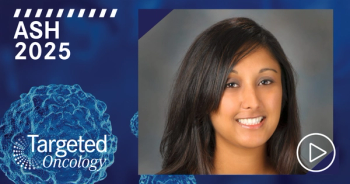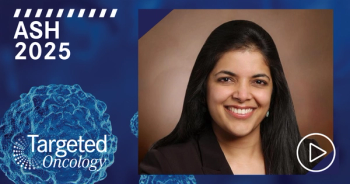
Case-Based Roundtable Meetings Spotlight
- Case-Based Roundtable Meeting Spotlight November 2, 2021
Chavez Discusses Systemic Therapy Challenges for Patients With Relapsed/Refractory DLBCL After CAR T-Cell Therapy Treatment
Eleven months after a 43-year-old woman with diffuse large B-cell lymphoma completed chimeric antigen receptor T-cell therapy, she complained of fever, night sweats, and back pain.
During a Targeted Oncology Case-Based Roundtable event, Julio Chavez, MD, MS, an associate Member in the Lymphoma Section Department of Malignant Hematology at H. Lee Moffitt Cancer Center & Research Institute, discussed the case of a 43-year-old patients with diffuse large B-cell lymphoma (DLBCL).
Targeted OncologyTM: Please discuss the National Comprehensive Cancer Network (NCCN) guidelines for treatment of relapsed/refractory (r/r) DLBCL.
CHAVEZ: The NCCN recommendations, [which reflect] the way we practice, show that after 2 months of therapy, we have 3 CAR T [chimeric antigen receptor T-cell] products approved, which is standard of care. Always consider clinical trials. Then there are other therapies, too, that we can discuss further. Some patients may not be healthy enough to do CAR T, transplant, or other palliative therapies.1
For second-line or subsequent therapies, specifically in noncandidates for transplantation, we have polatuzumab [Polivy]. Polatuzumab plus bendamustine and rituximab is approved for patients who have failed at least 2 kinds of therapy [and] who are not candidates for transplantation. You also have tafasitamab [Monjuvi] and lenalidomide [Revlimid]. The NCCN has been adding other agents, [such as] ibrutinib [Imbruvica] or brentuximab [Adcetris], and I have used [them], but the responses are [usually] short lived.
Something the NCCN panel has mentioned is that bendamustine should be used with caution unless it’s after leukapheresis. Prior to leukapheresis, we try to avoid it, so I tend to use polatuzumab and rituximab. Sometimes it’s been recommended to the doctors that send referrals to me, but it could be logistically difficult because they do not approve the whole regimen. They didn’t approve polatuzumab alone and it can be difficult to discuss, so sometimes we just drop bendamustine from the regimen.
Can you discuss the use of tafasitamab and loncastuximab (Zynlonta) in this setting?
CHAVEZ: A small number of patients have a different response from CAR T if they were exposed to CD19- based therapy. I like to avoid [that situation], but if you are running out of options and you have a patient who had tafasitamab or loncastuximab and you want to do CAR T, you should do it. There are a couple publications that show these patients respond to CAR T.
NAHAS: I have a question about this because I get this question all the time with patients who [are] candidates for CAR T. Are we naive to think loncastuximab, tafasitamab, and every single CD19-directed agent is going to hit the exact same antigen? These are all antigen-targeted therapies.
CHAVEZ: An epitope of the antigen, right? Probably yes, but I [must] be honest, I don’t know.…The other thing is that the mechanism of relapse in DLBCL is different than in ALL [acute lymphoblastic leukemia]. In ALL, the main mechanism is, when you have CD19 loss, you relapse, but in DLBCL, it happens in probably no more than 30% of cases.
That’s why I cannot argue that you should not use tafasitamab or loncastuximab if you are planning for CAR T. [My colleagues here at Moffitt Cancer Center] prefer not to do it, so I’m trying not to, but I have a bias because I have a clinical trial. When I have a patient and they cannot take a CAR T, I put them in a clinical trial, and it has a different mechanism of action [for them]. I would try to avoid it, but if you don’t have any other options, I wouldn’t be concerned. I would treat with tafasitamab, I would treat with loncastuximab, and the patient will probably respond to CAR T stimuli. I don’t think it will affect the efficacy of CAR T.
MURTHY: We’re not going to dissuade giving something that’s working. The question is whether that is really your last option at this point, and right now, I wouldn’t think it would be. Until I know more to say no, I would just say there are other options. But I’m never going to stop someone by saying, “Don’t give something effective.” Because if you don’t give something effective and the patient is in that bad of shape, you’re not going to get to CAR T.
I have not seen a lot of people using tafasitamab or loncastuximab before CAR, and I haven’t given it as bridging. If I [must] give chemotherapy, I usually give polatuzumab, and I’m trying not to give bendamustine before apheresis. Usually it’s apheresis, then I give pola-BR [polatuzumab vedotin plus bendamustine plus rituximab]. For some people who are a little frailer, I [am] probably giving them GDP [gemcitabine (Gemzar), dexamethasone (Decadron), and cisplatin] as a bridge. I have not given any CD19 [before] CAR T.
SANDOVAL-SUS: [Eventually, when we get more experience with that], this would potentially be a trial for real-world data. We had CAR T cells here at Memorial Sloan Kettering Cancer Center, I referred 2 patients that had been treated with tafasitamab, and they mobilized well. They collected and transfected very well. At 30 days, they were [both] in CR [complete remission]. I would argue that, eventually, when we get more information, if I [must] use it, I will use it.
MURTHY: Is it [mechanistically] different if you give the CD19 treatment post CAR T failure, or you give it before the CAR T?
CHAVEZ: The main mechanism of relapse post CAR T is not seen in antiloss; it’s something else....Remember you give tafasitamab with lenalidomide. Lenalidomide is known to modulate the microenvironment [and] improve NK [natural killer] cells [and] cytotoxic T cells. It’s a different mechanism of action that is out there. Patients are [probably] responding for that reason, and it enhances CD19-directed therapy. It’s been studied. Of all the drugs have been approved so far, loncastuximab is the only one that has data post CAR T relapse.
Ultimately, if any patient has r/r DLBCL, even if they have a relapse after 3 or 4 years in remission, I still can’t transplant, but I can underscore that every referral is important, especially for high-risk patients. That’s why I try to at least offer options to minimize CD19 exposure. Time will tell us what the real impact is, but so far, the small amount of data we have don’t support that it will affect CAR T response in the future, if you do decide to use it.
What are the data that support the use of pola-BR in DLBCL?
CHAVEZ: Polatuzumab’s mechanism of action is as an antibody-drug conjugate. It has a toxin. It binds into the microtubules to affect the cell cycle. It works better in aggressive tumors than slow-growing tumors. It targets CD79b.2
The trial for pola-BR [NCT02257567] was a phase 2 randomized trial, so the primary end point was overall response rate [ORR]. It was adult patients, at least 1 prior line of therapy, transplant ineligible, or a prior failure to transplant. There were 2 cohorts of patients: r/r follicular lymphoma and r/r DLBCL. Both cohorts had 80 patients each. Polatuzumab was given every 4 weeks at a regimen of up to 6 cycles. Bendamustine, 2 days, as standard dosing, rituximab also.3,4
The patient characteristics were similar [between the 2 treatment arms: pola-BR vs BR alone]. Maybe a little more women in the cohort for the pola-BR, but in general, pretty much an equal number of patients. At least 45% of patients had 3 or more lines of therapy and a majority were refractory to last therapy.
The primary end point [was evaluated] by independent review committee. The ORR [with pola-BR] was 45% with CR. So significantly better than BR [17.5%].4 Progression-free survival [PFS] was 9.5 months vs 3.7 months, the comparator with BR [HR, 0.36; 95% CI, 0.21-0.63; P < .001].6 What’s interesting is this study showed survival benefit. Remember this was a phase 2 randomized study, so overall survival [OS] was 12 months for pola-BR vs 4.7 months with BR [HR, 0.42; 95% CI, 0.24-0.75; P = .002]. The striking efficacy point was the CR response rates.
What is your reaction to the efficacy data for pola-BR?
SANDOVAL-SUS: I [usually] use this regimen to try to take somebody to a more definitive therapy. In that sense, I’m more impressed with the CR, and I’ll tell you why. I personally think this was an underpowered trial, and we need to be very careful with that interpretation. These patients have very good responses at the beginning, usually CRs, then they explode afterward. They just progress.
CHAVEZ: It is a very good bridge to something else. That’s what I can tell, as well. The design is a phase 2 randomized. There was placebo, but looking at the ORR, there is real-life experience, too. I wouldn’t say it is significantly different, but they have more heavily treated patients, so the OS was lower.
What toxicities do you mainly see when using pola-BR?
NAHAS: [So far], just some cytopenias, in my experience. I haven’t noticed any neuropathy yet, but cytopenias, if anything.
CHAVEZ: That’s true. [By itself], polatuzumab can cause cytopenia, which is a problem.5
SANDOVAL-SUS: Cytopenias and infections, but mostly cytopenias.
CHAVEZ: I honestly don’t see any infections with pola-BR, but it is true, you have more cytopenias.
Do you reduce the dose of bendamustine or polatuzumab if you have cytopenias?
SANDOVAL-SUS: I reduce the bendamustine and usually stop it, depending on how bad [and how prolonged] the cytopenias are. I usually focus more on the bendamustine.
CHAVEZ: Do you give a growth factor treatment?
MURTHY: Depends on how significant the cytopenias
[are]. Holding or reducing the bendamustine, and even proceeding with the cycles, they usually resolve. Obviously transfusions, but depends on how severe the cytopenias are.
CHAVEZ: I don’t use it routinely, but if I have a patient who [already had CAR T treatment], which is mainly our patients, I have to do growth factor, too, from the first cycle. I haven’t had issues getting approval with insurance, but I tend to use growth factors. Especially on patients who’ve had at least 3 lines of therapy post CAR T or post transplant.
What is your experience post CAR T cells with this regimen?
CHAVEZ: I’ve seen responses, but I don’t quite remember how good [they were]. Ultimately, it’s short lived and a good bridge to [another treatment].
MURTHY: [As you’ve said], my biggest issue has been some of these post-CAR cytopenias. I’ve [almost] had to recommend starting without bendamustine in the beginning just to get them some treatment, but the cytopenias are so pronounced.
I’ve still gotten some responses, so it’s not like I want to give them all the cycles without bendamustine, but sometimes that post-CAR cytopenia—you have to give something.
REFERENCES:
1. NCCN. Clinical Practice Guidelines in Oncology. B-cell lymphomas, version 4.2021. Accessed September 13, 2021. https://bit.ly/3geoS5N
2. Sawalha Y, Maddocks K. Profile of polatuzumab vedotin in the treatment of patients with relapsed/refractory non-Hodgkin lymphoma: a brief report on the emerging clinical data. Onco Targets Ther. 2020;13:5123-5133. doi:10.2147/OTT. S219449
3. Sehn LH, Kamdar M, Herrera AF, et al. Randomized phase 2 trial of polatuzumab vedotin (pola) with bendamustine and rituximab (BR) in relapsed/refractory (r/r) FL and DLBCL. J Clin Oncol. 2018;36(suppl 15):7507. doi:10.1200/ JCO.2018.36.15_suppl.7507
4. Sehn LH, Herrera AF, Flowers CR, et al. Polatuzumab vedotin in relapsed or refractory diffuse large B-cell lymphoma. J Clin Oncol. 2020;38(2):155-165. doi:10.1200/JCO.19.00172









































